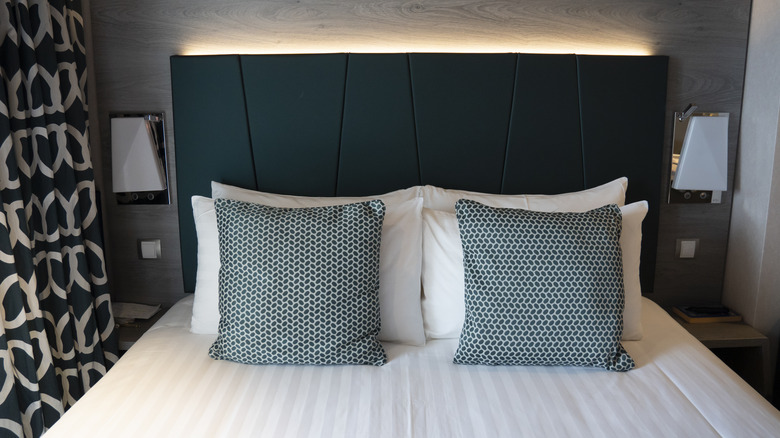Here's What Nobody Tells You About Interior Cabins On A Cruise
Picking a cabin on a cruise, whether on a luxury liner or a budget-friendly vessel, should be fairly straightforward. You're essentially only selecting out of a handful of options, after all. You can go for a suite, usually the largest accommodation complete with a separate bedroom, living area, and balcony; a balcony cabin, a more compact room with its own private balcony; an ocean view cabin, which enables you to enjoy stunning vistas the moment you wake up; or the interior cabin, the pick of the budget-savvy. As the name implies, it's a room nestled well within the heart of the ship, offering no views whatsoever. But while cost-effective, it has its fair share of downsides, like messing with your sleep.
The lack of portholes isn't the end of the world, however — even travel experts say so. "Not having a balcony or port hole is oftentimes not that bad and those inside cabins are the best deals on the ship," travel agent Jonathan de Araujo told CNN. And besides, choosing them doesn't mean you'll miss out on the ship's amenities, either. You're still a paying customer at the end of the day, so you can enjoy them just like everyone on the ship.
But here's a word of advice: Steer clear of the interior cabin if you sleep like a log or are prone to motion sickness. Not only will interior cabins bar you immediate access to the outside world, but their cozy nature makes it easier to oversleep.
They can wreak havoc on your sleep schedule
The main advantage of interior cabins: You can sleep like a baby. The main disadvantage of interior cabins: You tend to sleep like a baby. Because they don't have windows or direct access to any natural sources of light, you can expect pitch-black darkness when all forms of illumination are turned off. This is great for people who are more comfortable sleeping in the dark but bad for those who tend to rely on sunlight to be wide awake.
Complete darkness is a double-edged sword. It does allow for a more restful slumber, but for sunlight-dependent risers, the absence of natural light can disrupt your body's internal clock, potentially upending your circadian rhythm. In these windowless interior cabins, the lack of natural light means no gentle morning sun nudges to jolt you wide awake. This can lead to oversleeping, causing you to inadvertently miss out on exciting cruise activities you've planned for the day. It can also potentially disturb your sleep pattern for the duration of your voyage, leaving you cranky for the rest of the trip.
What's more, if you easily get seasick, interior cabins present a specific challenge. Without a window to crack open for a breath of fresh air, it may take longer to find relief from queasiness. If a natural breeze is what often alleviates your discomfort, you might want to consider upgrading to a cabin with easier access to the outdoors.
But don't fret, not all interior cabins lack views
Another thing about interior cabins that often goes unnoticed? The fact that not all of them are void of views. Setting the issue of potential oversleeping and motion sickness aside, there are some cruise companies that have started offering interior cabins with virtual windows, helping passengers avoid the feeling that they're entirely cut off from the outside world.
For instance, some Disney Cruises ships have cabins that feature so-called "magical portholes," which mimic the look of actual portholes and display live scenes from the ship's exterior. What makes them "magical," however, is that some fan-favorite Disney characters pop up on the screen at random times, bringing unexpected moments of delight to the occupants. Royal Caribbean has also embraced this trend with the introduction of virtual balconies in some of their ships. You unfortunately won't witness a Mickey Mouse cameo, but you do get stunning, high-definition ocean views. This experience is further amplified by the 80-inch screens that cover nearly an entire wall, so even if you're in an interior cabin, you get something close to a balcony room feel.
While these virtual portholes and balconies may not completely replicate the experience of real windows, they're a good enough alternative, particularly for those who might feel claustrophobic in a smaller cabin. Plus, they still remain a more economical choice compared to cabins with actual windows, allowing for both an enhanced experience and budget savings.
